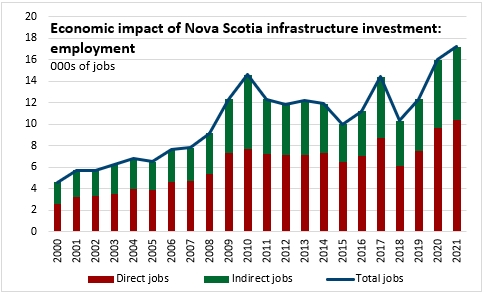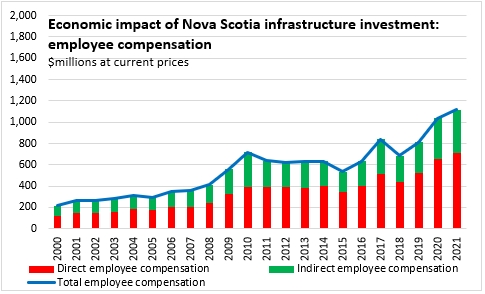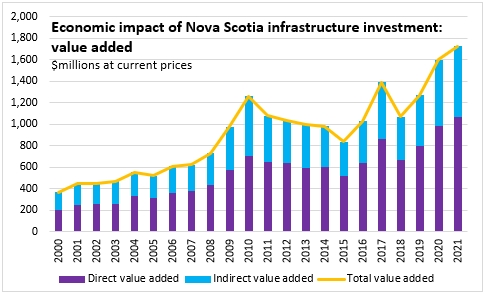The Economics and Statistics Division maintains archives of previous publications for accountability purposes, but makes no updates to keep these documents current with the latest data revisions from Statistics Canada. As a result, information in older documents may not be accurate. Please exercise caution when referring to older documents. For the latest information and historical data, please contact the individual listed to the right.
<--- Return to Archive
For additional information relating to this article, please contact:
June 20, 2022ECONOMIC IMPACT OF INFRASTRUCTURE EXPENDITURES, 2000-2021 As part of its recent release of infrastructure economic accounts for 2021, Statistics Canada has estimated the economic impacts associated with infrastructure investments over time. These impacts are measured in terms of jobs (headcount, not person-years), compensation of employees and value added in nominal terms. Note that compensation of employees is a component of value added.
Economic impacts are divided into direct impacts generated within the industry undertaking the investment and indirect impacts generated in industries that supply the directly-affected industry. The total economic impact is the sum of direct and indirect economic impact.
In 2021, Nova Scotia's investment in infrastructure amounted to $2.228 billion. This generated direct employment of 10,400 jobs as well as a further 6,800 in indirect employment among supplier industries for a total impact of 17,200. This total employment impact was up from 16,000 in 2020. In comparison, infrastructure investments generated 10,300 total jobs in 2018.

The total employment impacts of Nova Scotia's infrastructure investment in 2021 generated $713 million in direct employee compensation and a further $404 million in indirect employee compensation.

Including value added beyond compensation of employees, Nova Scotia's infrastructure investments in 2021 generated $1.06 billion in direct value added as well as $0.66 billion in indirect value added.

Notes: Infrastructure is defined as physical structures and systems that support the production of goods and service and their delivery to and consumption by governments, business and citizens. Infrastructure assets are tangible assets that generally enable or perform a support function and includes both economic asset (i.e. highways, road, energy generation/transmission, sewage systems) and social assets (i.e. hospitals, schools, pollution abatement, recreation facilities, law enforcement facilities). The value of the capital stock is measured using perpetual inventory method where investment are positive flows that accumulated the asset which is depreciated over time as assets age. Assets in the data can be separated by purchasing sector, asset type, or function. Infrastructure assets do not include all types of non-residential assets, for instance buses and trains are included while some other types of mobile assets (defense ships, aircraft, ambulances) are not considered part of infrastructure assets.
Source: Statistics Canada. Table 36-10-0608-01 Infrastructure Economic Accounts, investment and net stock by asset, industry, and asset function (x 1,000,000); Table 36-10-0610-01 Infrastructure Economic Accounts, economic impact by asset, industry, and asset function (x 1,000,000)
<--- Return to Archive